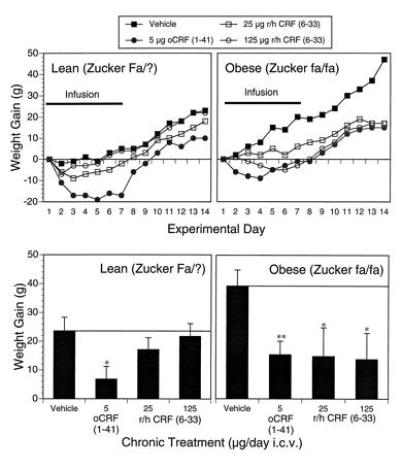Figure 1.

Comparison of CRF receptor agonist and CRF-BP ligand inhibitor actions on body weight in the Zucker model of obesity. Mean ± SEM body weight gain during and following 7-day, chronic, i.c.v. administration of vehicle, oCRF (1-41) (5 μg/day), or r/h CRF(6-33) (25 and 125 μg/day) is exhibited for Zucker lean [vehicle, n = 10; oCRF (1-41), n = 10; 25 μg of r/h CRF (6-33), n = 7; 125 μg of r/h CRF (6-33), n = 9] and obese [vehicle, n = 9; oCRF (1-41), n = 7; 25 μg of r/h CRF (6-33), n = 6; 125 μg of r/h CRF (6-33), n = 6] rats. (Upper) Daily weight change relative to pretreatment baseline weight and (Lower) cumulative weight gain over the 14 experimental days. Peptide treatment significantly reduced body weight gain [F(3,56) = 5.28, P < 0.005]. Mean ± SEM cumulative intake of vehicle-treated subjects was greater than that of peptide treated animals in both obese [vehicle, 325 ± 14 g; oCRF (1-41), 290 ± 15 g; 25 μg of r/h CRF (6-33), 301 ± 34 g; 125 μg of r/h CRF (6-33), 303 ± 26 g] and lean [vehicle, 236 ± 25 g; oCRF (1-41), 204 ± 22 g; 25 μg of r/h CRF (6-33), 182 ± 21 g; 125 μg of r/h CRF (6-33), 218 ± 21 g] cohorts, but these differences were not statistically significant. ∗, P < 0.05; ∗∗, P < 0.01, relative to respective vehicle control groups.
